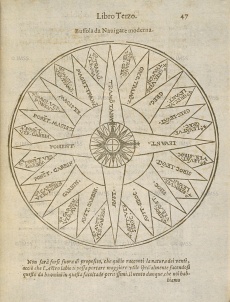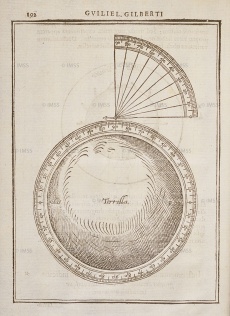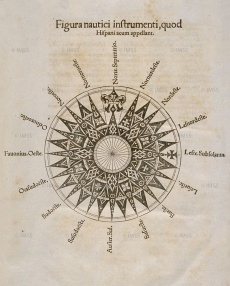Compass
From Inventions
m (1 revision) |
|||
| (6 intermediate revisions not shown) | |||
| Line 1: | Line 1: | ||
{{Template invention | {{Template invention | ||
| - | |nome= | + | |nome= |
| + | From the Latin "buxula" (box), derived in turn from "buxus" (boxwood). The name, in use since the Middle Ages, derives from the boxwood case that housed the magnetized needle. | ||
| - | |descrizione= | + | |descrizione= |
| + | The magnetic compass is an orientation instrument that consists of a magnetic needle pivoting freely around a pin, which always points north. Probably invented in China, the compass was introduced into Europe by the Arabs in the twelfth century. Due to misinterpretation of a Latin text by Flavio Biondo (''Amalphi in Campania veteri magnetis usus inventus a Flavio traditur''), the compass was believed in Renaissance times to have been invented by Flavio Gioia from Amalfi. The instrument was used mainly for navigation and surveying. From it comes the name of one of the most widely disseminated surveying instruments of the sixteenth century, the so-called bussola, or [[Surveying Compass | surveying compass]]. In sixteenth-century treatises it is also called "bossolo" or "bussolo della calamita". | ||
|inventore= | |inventore= | ||
| Line 14: | Line 16: | ||
|strumentiesistenti= | |strumentiesistenti= | ||
| + | - Museo Galileo, Institute and Museum of the History of Science, Florence <br> | ||
| + | [http://catalogo.museogalileo.it/oggetto/Bussola.html Florence, Museo Galileo. Institute and Museum of the History of Science, inv. 3182] <br /> | ||
| + | |||
| + | |||
| + | - Musée des arts et métiers, Paris<br> | ||
| + | [http://cugnot.cnam.fr:8000/SEARCH/BASIS/collec/internet/objet/DDW?W%3DDESIG+PH+WORDS+%27boussole%27+ORDER+BY+DESIG/Ascend%26M%3D25%26K%3D479%26R%3DY%26U%3D1 Paris, Musée des arts et metiers, inv. 08431-0000-] <br /> | ||
| + | [http://cugnot.cnam.fr:8000/SEARCH/BASIS/collec/internet/objet/DDW?W%3DDESIG+PH+WORDS+%27boussole%27+ORDER+BY+DESIG/Ascend%26M%3D27%26K%3D2862%26R%3DY%26U%3D1 Paris, Musée des arts et metiers, inv. 07460-0000-] <br /> | ||
| + | [http://cugnot.cnam.fr:8000/SEARCH/BASIS/collec/internet/objet/DDW?W%3DDESIG+PH+WORDS+%27boussole%27+ORDER+BY+DESIG/Ascend%26M%3D13%26K%3D2884%26R%3DY%26U%3D1 Paris, Musée des arts et metiers, inv. 04280-0000-] <br /> | ||
| + | |||
| + | |||
| + | - The Science Museum, London<br> | ||
| + | [http://www.ingenious.org.uk/See/?s=S1&ObjectID={EC3D8C94-61BE-7AF1-54DC-AACE438460ED}&source=Search&target=SeeMedium The Science museum, inv. 1980-1624]<br> | ||
| + | [http://www.ingenious.org.uk/See/?s=S1&ObjectID={668FFD56-8948-7A90-429F-E34DE1C5C610}&source=Search&target=SeeMedium The Science museum, inv. 1880-93]<br> | ||
| + | [http://www.ingenious.org.uk/See/?target=SeeMedium&ObjectID={8C236389-5322-CF50-D04F-2AB5ACDC8275}&SearchString=Compass&source=Search&viewby=images The Science museum, "Silva compass, 1999"]<br> | ||
| + | [http://www.ingenious.org.uk/See/?s=S1&ObjectID={9D83F6E6-3534-375A-B3DA-F1CCD939F378}&source=Search&target=SeeMedium The Science museum, inv. 1975-177]<br> | ||
| + | [http://www.ingenious.org.uk/See/?s=S1&ObjectID={AAB872A6-D0F9-EC73-8D56-2C9EA7236126}&source=Search&target=SeeMedium The Science museum, inv. 1981-1359]<br> | ||
| + | [http://www.ingenious.org.uk/See/?target=SeeMedium&ObjectID={8AEDBA47-810C-AF65-E24B-50A3FF94E771}&SearchString=Compass&source=Search&viewby=images The Science museum, "Octagonal Louis XVI sundial and compass, French, early 18th Century"]<br> | ||
| + | [http://www.ingenious.org.uk/See/?s=S1&ObjectID={7420BEEE-1485-4DEF-798B-2AF52EAFE860}&source=Search&target=SeeMedium The Science museum, inv. 1924-346]<br> | ||
| + | [http://www.ingenious.org.uk/See/?s=S1&ObjectID={6DF551F0-276F-0562-CA86-4B4FAA6CB52B}&source=Search&target=SeeMedium The Science museum, inv. 1876-801]<br> | ||
| + | [http://www.ingenious.org.uk/See/?target=SeeMedium&ObjectID={59650F9B-40D2-EC2B-8AA6-A6F4B369894E}&s=S1&SearchString=Compass&source=Search&viewby=images&cntRead=3&cntDebate=0&cntDCBooks=3&cntDCImages=132& The Science museum, inv. " Azimuth compass sundial, 1731-1776"]<br> | ||
| + | |||
| + | |||
| + | |||
| + | - Museum of the History of Science, Oxford <br> | ||
| + | [http://emu.mhs.ox.ac.uk/Display.php?irn=3475&QueryPage=%2FAdvQuery.php Museum of the History of Science, Oxford, inv. 47707]<br> | ||
| + | [http://emu.mhs.ox.ac.uk/Display.php?irn=10156&QueryPage=%2FAdvQuery.php Museum of the History of Science, Oxford, inv. 86517]<br> | ||
| + | [http://emu.mhs.ox.ac.uk/Display.php?irn=3484&QueryPage=%2FAdvQuery.php Museum of the History of Science, Oxford, inv. 39530]<br> | ||
| + | [http://emu.mhs.ox.ac.uk/Display.php?irn=3507&QueryPage=%2FAdvQuery.php Museum of the History of Science, Oxford, inv. 42644]<br> | ||
| + | [http://emu.mhs.ox.ac.uk/Display.php?irn=3009&QueryPage=%2FAdvQuery.php Museum of the History of Science, Oxford, inv. 33556]<br> | ||
| + | [http://emu.mhs.ox.ac.uk/Display.php?irn=2864&QueryPage=%2FAdvQuery.php Museum of the History of Science, Oxford, inv. 52880]<br> | ||
| + | [http://emu.mhs.ox.ac.uk/Display.php?irn=3499&QueryPage=%2FAdvQuery.php Museum of the History of Science, Oxford, inv. 47409]<br> | ||
| + | [http://emu.mhs.ox.ac.uk/Display.php?irn=2957&QueryPage=%2FAdvQuery.php Museum of the History of Science, Oxford, inv. 39318]<br> | ||
| + | [http://emu.mhs.ox.ac.uk/Display.php?irn=10147&QueryPage=%2FAdvQuery.php Museum of the History of Science, Oxford, inv. 22794]<br> | ||
| + | [http://emu.mhs.ox.ac.uk/Display.php?irn=9731&QueryPage=%2FAdvQuery.php Museum of the History of Science, Oxford, inv. 33425]<br> | ||
| + | [http://emu.mhs.ox.ac.uk/Display.php?irn=17622&QueryPage=%2FAdvQuery.php Museum of the History of Science, Oxford, inv. 11451]<br> | ||
| + | [http://emu.mhs.ox.ac.uk/Display.php?irn=17590&QueryPage=%2FAdvQuery.php Museum of the History of Science, Oxford, inv. 11419]<br> | ||
| + | [http://emu.mhs.ox.ac.uk/Display.php?irn=3007&QueryPage=%2FAdvQuery.php Museum of the History of Science, Oxford, inv. 39052]<br> | ||
| + | [http://emu.mhs.ox.ac.uk/Display.php?irn=10183&QueryPage=%2FAdvQuery.php Museum of the History of Science, Oxford, inv. 64558]<br> | ||
| + | [http://emu.mhs.ox.ac.uk/Display.php?irn=17609&QueryPage=%2FAdvQuery.php Museum of the History of Science, Oxford, inv. 11438]<br> | ||
| + | |||
| + | |||
|link= | |link= | ||
| + | |||
| + | http://www.anisn.it/geologia2000/A_bussola.html (Italian)<br> | ||
| + | http://www.vieferrate.it/bussola.htm (Italian)<br> | ||
| + | http://www.jpfil.com/boussole/index.html (French)<br> | ||
| + | http://www.learn-orienteering.org/old/ (English) | ||
|immagini= <gallery widths=230 heights=368 perrow=3> | |immagini= <gallery widths=230 heights=368 perrow=3> | ||
Current revision as of 13:18, 7 September 2010
From the Latin "buxula" (box), derived in turn from "buxus" (boxwood). The name, in use since the Middle Ages, derives from the boxwood case that housed the magnetized needle.
Contents |
Historic Period
10th-12th C.
Description
The magnetic compass is an orientation instrument that consists of a magnetic needle pivoting freely around a pin, which always points north. Probably invented in China, the compass was introduced into Europe by the Arabs in the twelfth century. Due to misinterpretation of a Latin text by Flavio Biondo (Amalphi in Campania veteri magnetis usus inventus a Flavio traditur), the compass was believed in Renaissance times to have been invented by Flavio Gioia from Amalfi. The instrument was used mainly for navigation and surveying. From it comes the name of one of the most widely disseminated surveying instruments of the sixteenth century, the so-called bussola, or surveying compass. In sixteenth-century treatises it is also called "bossolo" or "bussolo della calamita".
Existing Instruments
- Museo Galileo, Institute and Museum of the History of Science, Florence
Florence, Museo Galileo. Institute and Museum of the History of Science, inv. 3182
- Musée des arts et métiers, Paris
Paris, Musée des arts et metiers, inv. 08431-0000-
Paris, Musée des arts et metiers, inv. 07460-0000-
Paris, Musée des arts et metiers, inv. 04280-0000-
- The Science Museum, London
The Science museum, inv. 1980-1624
The Science museum, inv. 1880-93
The Science museum, "Silva compass, 1999"
The Science museum, inv. 1975-177
The Science museum, inv. 1981-1359
The Science museum, "Octagonal Louis XVI sundial and compass, French, early 18th Century"
The Science museum, inv. 1924-346
The Science museum, inv. 1876-801
The Science museum, inv. " Azimuth compass sundial, 1731-1776"
- Museum of the History of Science, Oxford
Museum of the History of Science, Oxford, inv. 47707
Museum of the History of Science, Oxford, inv. 86517
Museum of the History of Science, Oxford, inv. 39530
Museum of the History of Science, Oxford, inv. 42644
Museum of the History of Science, Oxford, inv. 33556
Museum of the History of Science, Oxford, inv. 52880
Museum of the History of Science, Oxford, inv. 47409
Museum of the History of Science, Oxford, inv. 39318
Museum of the History of Science, Oxford, inv. 22794
Museum of the History of Science, Oxford, inv. 33425
Museum of the History of Science, Oxford, inv. 11451
Museum of the History of Science, Oxford, inv. 11419
Museum of the History of Science, Oxford, inv. 39052
Museum of the History of Science, Oxford, inv. 64558
Museum of the History of Science, Oxford, inv. 11438
Links (External)
http://www.anisn.it/geologia2000/A_bussola.html (Italian)
http://www.vieferrate.it/bussola.htm (Italian)
http://www.jpfil.com/boussole/index.html (French)
http://www.learn-orienteering.org/old/ (English)
Images
Pedro Nunes. Opera quae complectuntur primum duos libros, in quorum priore tractantur pulcherrima problemata, in altero traduntur ex mathematicis disciplinis regulae & instrumenta artis nauigandi, quibus uaria rerum astronomicarum phainomena circa coelestium corporum motus explorare possumus: deinde Annotationes in Aristotelis problema mechanicum de motu nauigij ex remis , Basileae, 1566. |
Author of the entry: Filippo Camerota



